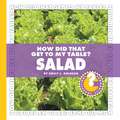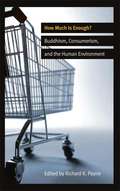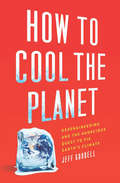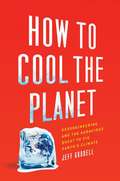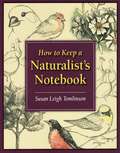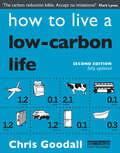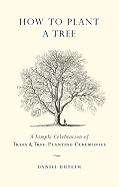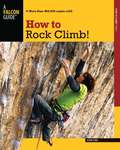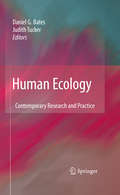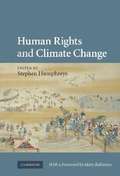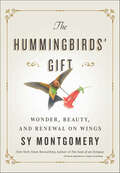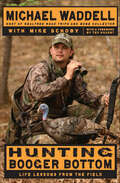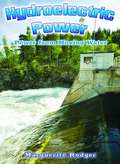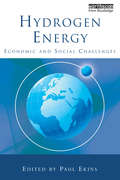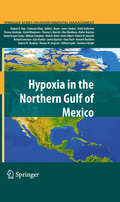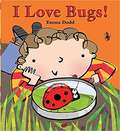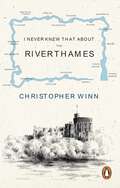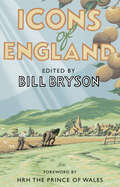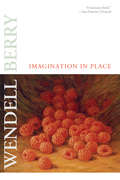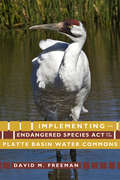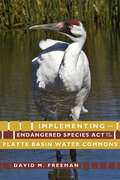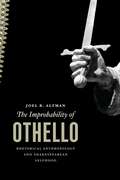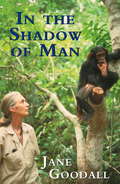- Table View
- List View
How Did That Get to My Table? Salad (Community Connections)
by Emily J. DolbearYoung readers will gain an understanding on how salad is grown and how it ends up on their table. Picture descriptions added.
How Much is Enough?
by Richard K. PayneThe massive outpouring of consumer products available today might alone lead one to ask "How much is enough?" But at the same time, if we allow ourselves to see the social, political, economic and environmental consequences of the system that produces such a mass of "goods," then the question is not simply a matter of one's own personal choice, but points to the profound interconnectedness of our day to day decisions about "How much is enough?" The ease with which we can acquire massive quantities of food, clothing, kitchenware, and various electronic goods directly connects each of us with not only environmental degradation caused by strip mining in West Virginia, and with sweat shops and child labor in India or Africa, but also with the ongoing financial volatility of Western capitalist economies, and the increasing discrepancies of wealth in all countries. This interconnectedness is the human environment, a phrase intended to point toward the deep interconnection between the immediacy of our own lives, including the question of "How much is enough?," and both the social and natural worlds around us. This collection brings together essays from an international conference jointly sponsored by Ryukoku University, Kyoto, and the Institute of Buddhist Studies, Berkeley. The effects of our own decisions and actions on the human environment is examined from several different perspectives, all informed by Buddhist thought. The contributors are all simultaneously Buddhist scholars, practitioners, and activists - thus the collection is not simply a conversation between these differing perspectives, but rather demonstrates the integral unity of theory and practice for Buddhism.
How to Cool the Planet
by Jeff GoodellRight now, a group of scientists is working on ways to minimize the catastrophic impact of global warming. But they're not designing hybrids or fuel cells or wind turbines. They're trying to lower the temperature of the entire planet. And they're doing it with huge contraptions that suck CO2 from the air, machines that brighten clouds and deflect sunlight away from the earth, even artificial volcanoes that spray heat-reflecting particles into the atmosphere. This is the radical and controversial world of geoengineering, which only five years ago was considered to be "fringe." But as Jeff Goodell points out, the economic crisis, combined with global political realities, is making these ideas look sane, even inspired. Goodell himself started out as a skeptic, concerned about tinkering with the planet's thermostat. We can't even predict next week's weather, so how are we going to change the temperature of whole regions? What if a wealthy entrepreneur shoots particles into the stratosphere on his own? Who gets blamed if something goes terribly wrong? And perhaps most disturbing, what about wars waged with climate control as the primary weapon? There are certainly risks, but Goodell believes the alternatives could be worse. In the end, he persuades us that geoengineering may just be our last best hope--a Plan B for the environment. His compelling tale of scientific hubris and technical daring is sure to jump-start the next big debate about the future of life on earth.
How to Cool the Planet: Geoengineering and the Audacious Quest to Fix Earth's Climate
by Jeff GoodellWhen Jeff Goodell first encountered the term "geoengineering," he had a vague sense that it involved outlandish schemes to counteract global warming. As a journalist, he was deeply skeptical. But he was also intrigued. The planet was in trouble. Could geoengineers help? Climate change may well be the biggest crisis humanity has ever faced. Temperatures in some regions of the world could increase by as much as fifteen degrees by the end of the century, causing rising sea levels and severe droughts. But change could also happen much more suddenly. What if we had a real climate emergency, the ecological equivalent of the subprime mortgage meltdown -- how could we cool the planet in a hurry? As Goodell shows in this bracing book, even if we could muster the political will for it, cutting greenhouse gas emissions alone may not be enough to reduce the risk of climate catastrophe. This has led some scientists to pursue extreme solutions: huge contraptions that would suck CO2 from the air, machines that would brighten clouds and deflect sunlight away from the earth, even artificial volcanoes that would spray heat-reflecting particles into the atmosphere. In How to Cool the Planet, Goodell explores the scientific, political, financial, and moral aspects of geoengineering. How are we to change the temperature of whole regions if we can't even predict next week's weather? What if a wealthy entrepreneur shoots particles into the stratosphere on his own? What about wars waged with climate control as the primary weapon? What happens to our relationship with nature when, as Goodell puts it, we all find ourselves living in a giant terrarium? And our options are dwindling. Maybe, Goodell suggests, we need to start taking geoengineering seriously. Maybe it's Plan B for the planet. And if it is, we need to know enough to get it right. Thoroughly reported and convincingly argued, How to Cool the Planet is a compelling tale of scientific hubris and technical daring. But it is also a thoughtful, even-handed look at a deeply complex and controversial issue. It's a book that will surely jump-start the next big debate about the future of life on earth.
How To Keep A Naturalist's Notebook
by Susan Leigh TomlinsonA one-of-a-kind, art-filled how-to guide geared to wildlife students and naturalists, based on the author's college course. Pages from actual field notebooks clearly illustrate what works and why. Hints and advice for outdoorspeople with even limited artistic skills.
How to Live a Low-Carbon Life: The Individual's Guide to Tackling Climate Change
by Chris GoodallDrastic reduction of carbon emissions is vital if we are to avoid a catastrophe that devastates large parts of the world. Governments and businesses have been slow to act - individuals need to take the lead now if we are to avoid climate chaos. Each Westener is responsible for an average 10 - 20 tonnes of carbon emissions each year (depending on where you live). In How to Live a Low-Carbon Life, Chris Goodall shows how easy it is to take responsibility, providing a comprehensive, one-stop reference guide to calculating your CO2 emissions and reducing them to a more sustainable 2 tonnes a year. This fully revised and expanded new edition takes into account new government targets on emissions reductions and includes up-to-date calculations and extensive graphics clearly laying out the path to a low-carbon life.
How to Plant a Tree
by Daniel ButlerA gorgeously packaged, very practical little book explains exactly how to plant and care for a tree and celebrates trees and their life-affirming presence in our lives. The earth's longest living organisms, trees exemplify nature's great strength as well as its majestic beauty. Serving as virtual lungs for our planet, trees provide us with food, medicine, and our most versatile building material. To plant a tree is to plant hope, and as an act of commemoration, it literally gives life to that remembered. While it is in-deed a practical book that explains exactly how to plant and care for a tree, HOW TO PLANT A TREE is so much more. Drawing on the ancient rituals and folklore that surround particular trees, the author explores their symbolism and traditional uses, and offers suggestions for various commemorative tree-planting acts, such as: A marriage ceremony; A new baby ceremony; A new home ceremony; A memorial for a loved one. With lovely original black-and-white illustrations throughout, HOW TO PLANT A TREE encompasses a wealth of both useful and inspiring information, including fascinating miscellany on some of our most beloved tree species like the willow, the oak, and the plum; how to calculate a tree's age; and how you can use trees to fight climate change. HOW TO PLANT A TREE will inspire readers to view trees as living structures of hope that will be treasured for generations to come.
How to Rock Climb, (How to Climb Series)
by John LongThoroughly revised and updated to reflect the modern standards of equipment, technique, and training methods, this guide includes sections on face climbing; crack climbing; ropes, anchors, and belays; getting off the rock; sport climbing; and much more. It is the essential how-to book for rock climbers everywhere.
Human Ecology
by Daniel G. Bates Judith TuckerThis comprehensive sourcebook on human ecology combines 25 source articles published in the journal Human Ecology, enhanced with new research updates and thematic commentary. Intended as a follow up to Case Studies in Human Ecology, this volume includes an entirely new group of articles, with the same accessible, comprehensive coverage that made Case Studies so popular. Human Ecology: Research and Practice covers four important areas: Philosophy, Theory and Methods; Changing Subsistence Practices; Agricultural Intensification and Population Dynamics; and, Common Property Resources and Conservation. As a group, these articles represent the major contributions to the study of Human Ecology since the publication of the previous volume. Each article includes a concise introduction by the Editor, giving necessary and thoughtful context. The volume covers an overview of human ecology as a field within environmental studies, new directions in contemporary research, new methods and techniques, and cultural landscapes. Anyone studying human ecology, environmental studies, landscape studies, or population dynamics, particularly key issues such as conservation and globalization will find this comprehensive reader a valuable resource.
Human Rights and Climate Change
by Stephen Humphreys Mary RobinsonAs the effects of climate change continue to be felt, appreciation of its future transformational impact on numerous areas of public law and policy is set to grow. Among these, human rights concerns are particularly acute. They include forced mass migration, increased disease incidence and strain on healthcare systems, threatened food and water security, the disappearance and degradation of shelter, land, livelihoods and cultures, and the threat of conflict. This inquiry into the human rights dimensions of climate change looks beyond potential impacts to examine the questions raised by climate change policies: accountability for extraterritorial harms; constructing reliable enforcement mechanisms; assessing redistributional outcomes; and allocating burdens, benefits, rights and duties among perpetrators and victims, both public and private. The book examines a range of so-far unexplored theoretical and practical concerns that international law and other scholars and policy-framers will find increasingly difficult to ignore.
The Hummingbirds' Gift: Wonder, Beauty, and Renewal on Wings
by Sy MontgomeryFrom the beloved New York Times bestselling author of the &“fascinating…entertaining&” (The Daily Beast) National Book Award finalist The Soul of an Octopus, a charmingly perfect gem of a book about the most exquisite and extraordinary of winged creatures—hummingbirds.As one of the most beautiful and intriguing birds found in nature, hummingbirds fascinate people around the world. The lightest birds in the sky, hummingbirds are capable of incredible feats, such as flying backwards, diving at speeds of sixty-one MPH, and beating their wings more than sixty times a second. Miraculous creatures, they are also incredibly vulnerable when they first emerge from their eggs. That&’s where Brenda Sherburn comes in.With tenderness and patience, she rescues abandoned hummingbirds and nurses them back to health until they can fly away and live in the wild. In The Hummingbird&’s Gift, the extraordinary care that Brenda provides her peanut-sized patients is revealed and, in the process, shows us just how truly amazing hummingbirds are. With Sy Montgomery&’s signature &“joyful passion&” (Library Journal), and including sixteen pages of gorgeous color photos, this beautifully written and inspiring little book celebrates the profound gift that hummingbirds are to our planet and is the ultimate gift for nature lovers and bird watchers everywhere.
Hunting Booger Bottom: Life Lessons from the Field
by Michael Waddell Mike Schoby“Michael [Waddell] is the real McCoy. Down to earth, clever, genuine, well-grounded, funny as all hell, kind, generous, decent, and surely one of the best natural hunters and woodsmen that I have ever grilled a sacred backstrap with.” —Ted Nugent From hunting legend Michael Waddell, star of multiple Outdoor Channel programs, comes a poignant and funny book about growing up in rural Georgia: Hunting Booger Bottom. Waddell offers priceless anecdotes from his lifetime of hunting with the fascinating—and often hilarious—cast of characters he’s met along the way. Breathtaking and dramatic, filled with practical advice and indelible folk wisdom—and a foreword by Ted Nugent—Hunting Booger Bottom offers an impassioned defense of sport hunting and is a must-read for anyone who has ever wandered the woods with “a stick and a string” (as Waddell refers to his bow.)
Hydroelectric Power: Power From Moving Water
by Marguerite RodgerHarnessing energy from water provides clean, available power that does not release harmful chemicals or carbons into the air. This interesting book explains how hydro turbines, transformers, and power lines work to bring light to the world and gives tips on how to conserve electricity and become more environmentally conscious.
Hydrogen Energy: Economic and Social Challenges
by Paul EkinsHydrogen could be a significant fuel of the future, with the potential to make a major contribution to the resolution of pressing social and environmental problems such as carbon emissions, energy security and local air pollution. This book, based on four years of detailed research, subjects the promise and potential of hydrogen to searching, in-depth socio-economic analysis. It discusses the different technologies for the production, distribution, storage and use of hydrogen, and analyses the economics of these technologies and their current market prospects. It also describes various experiences with aspects of a hydrogen economy in two parts of the world - the UK and Canada - and then assesses the nature of different hydrogen futures that might develop depending on how the technology, economics, social acceptance and policy frameworks play out in different contexts. The book ends by setting out the policy drivers and levers which could stimulate a virtuous circle of research and development, innovation and investment that might ultimately generate a sustainable hydrogen economy. This is essential reading for economists, engineers, business leaders, investors, policy makers, researchers and students who are interested in the future of the energy system and the part that hydrogen might play in it.
Hypoxia in the Northern Gulf of Mexico
by James Sanders Clifford S. Snyder Hans Paerl Mark David William Crumpton Denis Gilbert Alan Blumberg Daniel J. Conley Andrew N. Sharpley Thomas Bianchi Thomas W. Simpson Thomas Armitage Donelson Wright Holly Stallworth Catherine L. Kling Virginia H. Dale David Wangsness Kenneth Reckhow Kyle Mankin Richard Lowrance Robert W. Howarth Judith L. Meyer Walter Boynton James OpaluchThe goal of the book is to examine scientific advances since 2000 that may have increased understanding and options in three general areas related to hypoxia: Characterization the Cause(s) of Hypoxia. The physical, biological and chemical processes that affect the development, persistence and extent of hypoxia in the northern Gulf of Mexico. Characterization of Nutrient Fate, Transport and Sources. Nutrient loadings, fate, transport and sources in the Mississippi River that impact Gulf Hypoxia. Scientific Basis for Goals and Management Options. The scientific basis for, and recommended revisions to, the goals proposed in the Action Plan; and the scientific basis for the efficacy of recommended management actions to reduce nutrient flux from point and nonpoint sources. In addressing the state of the science, the book focuses on the strengths and limitations of the science in managing the Gulf hypoxia problem, including available data, models and model results and uncertainty. It includes work from the following authors: C. Kling, Iowa State University, Ames, IA, USA; J.L. Meyer, University of Georgia, Athens, GA, USA; J. Sanders, Skidaway Institute of Oceanography, Savannah, GA, USA; H. Stallworth, Environmental Protection Agency, Washington D.C., USA; T. Armitage, Environmental Protection Agency,Washington, D.C., USA; D. Wangsness, U.S. Geological Survey, Atlanta, GA, USA; T.S. Bianchi, Texas A&M University, College Station, TX, USA; A. Blumberg, Stevens Institute of Technology, Hoboken, NJ, USA; W. Boynton, University of Maryland, MD, USA; D.J. Conley, Lund University, Lund, Sweden; W. Crumpton, Iowa State University, Ames, IA, USA; M.B. David, University of Illinois, Urbana, IL, USA; D. Gilbert, Maurice-Lamontagne Institute, Mont-Joli, Quebec, Canada; R.W. Howarth, Cornell University, Ithaca, NY, USA; R. Lowrance, Agricultural Research Service, USDA, Tifton, GA, USA; K. Mankin, Kansas State University, Manhattan, KS, USA; J. Opaluch, University of Rhode Island, Kingston, RI, USA; H. Paerl, University of North Carolina, Chapel Hill, Morehead City, NC, USA; K. Reckhow, Duke University, Durham, NC, USA; A.N. Sharpley, University of Arkansas, Fayetteville, AR, USA; T.W. Simpson, University of Maryland, College Park, MD, USA; C. Snyder, International Plant Nutrition Institute,USA; Conway, AR; D. Wright, College of William and Mary, Gloucester Point, VA, USA.
I Love Bugs!
by Emma DoddCome on a creepy-crawly bug safari through one little boy's garden . . . with a brilliant surprise at the end. Perfect for bug-lovers and budding scientists everywhere! With fun rhyming text and bright, bold artwork, perfect for sharing and reading aloud.
I Never Knew That About the River Thames
by Christopher WinnBestselling author Christopher Winn takes us on a captivating journey out of London along the banks of the River Thames to discover the secrets and stories of England's most famous waterway. Discover the Thames's literary heritage at Pangbourne, near Reading, famous as the home of The Wind in the Willows's Kenneth Grahame, then explore Mapledurham House, the inspiration for its famous Toad Hall. Explore Henley-on-Thames, where the first Oxford and Cambridge boat races were held, then marvel at Southend Pier, the longest pleasure pier in the world.As he follows the river from source to sea, visiting its towns, villages and places of interest, Winn unearths a fascinating array of facts, folklore, landmarks and legends that are guaranteed to have you exclaiming 'I Never Knew That!'. Illustrated with line drawings this charming gem of a book is guaranteed to inform and delight in equal measure.
Icons of England
by Bill BrysonThis celebration of the English countryside does not only focus on the rolling green landscapes and magnificent monuments that set England apart from the rest of the world. Many of the contributors bring their own special touch, presenting a refreshingly eclectic variety of personal icons, from pub signs to seaside piers, from cattle grids to canal boats, and from village cricket to nimbies. First published as a lavish colour coffeetable book, this new expanded paperback edition has double the original number of contributions from many celebrities including Bill Bryson, Michael Palin, Eric Clapton, Bryan Ferry, Sebastian Faulks, Kate Adie, Kevin Spacey, Gavin Pretor-Pinney, Richard Mabey , Simon Jenkins, John Sergeant, Benjamin Zephaniah, Joan Bakewell, Antony Beevor, Libby Purves, Jonathan Dimbleby, and many more: and a new preface by HRH Prince Charles.
Imagination in Place
by Wendell Berry“Berry's latest collection of essays is the reminiscence of a literary life. It is a book that acknowledges a lifetime of intellectual influences, and in doing so, positions Berry more squarely as a cornerstone of American literature . . . A necessary book. Here, Berry's place as the 'grandfather of slow food' or the 'prophet of rural living' is not questioned. This book ensures we understand the depth and breadth of Berry's art.” —San Francisco Chronicle “[A] stellar collection . . . Foodies, architects, transportation engineers, and other writers are adopting and adapting [Berry’s] concepts, perhaps leading to what he envisions will one day be 'an authentic settlement of our country.'“ —The OregonianA writer who can imagine the “community belonging to its place” is one who has applied his knowledge and citizenship to achieve the goal to which Wendell Berry has always aspired—to be a native to his own local culture. And for Berry, what is “local, fully imagined, becomes universal,” and the “local” is to know one's place and allow the imagination to inspire and instill “a practical respect for what is there besides ourselves."In Imagination in Place, we travel to the local cultures of several writers important to Berry's life and work, from Wallace Stegner's great West and Ernest Gaines' Louisiana plantation life to Donald Hall's New England, and on to the Western frontier as seen through the Far East lens of Gary Snyder. Berry laments today's dispossessed and displaced, those writers and people with no home and no citizenship, but he argues that there is hope for the establishment of new local cultures in both the practical and literary sense.Rich with Berry's personal experience of life as a Kentucky agrarian, the collection includes portraits of a few of America's most imaginative writers, including James Still, Hayden Carruth, Jane Kenyon, John Haines, and several others.
Implementing the Endangered Species Act on the Platte Basin Water Commons (G - Reference, Information And Interdisciplinary Subjects Ser.)
by David M. FreemanWater users of the Platte River Basin have long struggled to share this scarce commodity in the arid high plains, ultimately organizing collectively owned and managed water systems, allocating water along extensive stream systems, and integrating newer groundwater with existing surface-water uses. In 1973, the Endangered Species Act brought a new challenge: incorporating the habitat needs of four species-the whooping crane, piping plover, least tern, and pallid sturgeon-into its water-management agenda. Implementing the Endangered Species Act on the Platte Basin Water Commons tells of the negotiations among the U.S. Department of the Interior, the environmental community, and the states of Wyoming, Colorado, and Nebraska that took place from the mid-1970s to 2006. Ambitious talks among rival water users, environmentalists, state authorities, and the Department of the Interior finally resulted in the Platte River Habitat Recovery Program. Documenting how organizational interests found remedies within the conditions set by the Endangered Species Act, describing how these interests addressed habitat restoration, and advancing sociological propositions under which water providers transcended self-interest and produced an agreement benefiting the environment, this book details the messy process that took place over more than thirty years. Presenting important implications for the future of water management in arid and semi-arid environments, this book will be of interest to anyone involved in water management, as well as academics interested in the social organization of common property.
Implementing the Endangered Species Act on the Platte Basin Water Commons
by David M. FreemanWater users of the Platte River Basin have long struggled to share this scarce commodity in the arid high plains, ultimately organizing collectively owned and managed water systems, allocating water along extensive stream systems, and integrating newer groundwater with existing surface-water uses. In 1973, the Endangered Species Act brought a new challenge: incorporating the habitat needs of four species-the whooping crane, piping plover, least tern, and pallid sturgeon-into its water-management agenda. Implementing the Endangered Species Act on the Platte Basin Water Commons tells of the negotiations among the U.S. Department of the Interior, the environmental community, and the states of Wyoming, Colorado, and Nebraska that took place from the mid-1970s to 2006. Ambitious talks among rival water users, environmentalists, state authorities, and the Department of the Interior finally resulted in the Platte River Habitat Recovery Program. Documenting how organizational interests found remedies within the conditions set by the Endangered Species Act, describing how these interests addressed habitat restoration, and advancing sociological propositions under which water providers transcended self-interest and produced an agreement benefiting the environment, this book details the messy process that took place over more than thirty years. Presenting important implications for the future of water management in arid and semi-arid environments, this book will be of interest to anyone involved in water management, as well as academics interested in the social organization of common property.
The Improbability of Othello: Rhetorical Anthropology and Shakespearean Selfhood
by Joel B. AltmanShakespeare’s dramatis personae exist in a world of supposition, struggling to connect knowledge that cannot be had, judgments that must be made, and actions that need to be taken. For them, probability—what they and others might be persuaded to believe—governs human affairs, not certainty. Yet negotiating the space of probability is fraught with difficulty. Here, Joel B. Altman explores the problematics of probability and the psychology of persuasion in Renaissance rhetoric and Shakespeare’s theater.Focusing on the Tragedy of Othello, Altman investigates Shakespeare’s representation of the self as a specific realization of tensions pervading the rhetorical culture in which he was educated and practiced his craft. In Altman’s account, Shakespeare also restrains and energizes his audiences’ probabilizing capacities, alternately playing the skeptical critic and dramaturgic trickster. A monumental work of scholarship by one of America’s most respected scholars of Renaissance literature, The Improbability of Othello contributes fresh ideas to our understanding of Shakespeare’s conception of the self, his shaping of audience response, and the relationship of actors to his texts.
In the Garden with Dr. Carver
by Nicole Tadgell Susan GrigsbySally is a young girl living in rural Alabama in the early 1900s, a time when people were struggling to grow food in soil that had been depleted by years of cotton production. One day, Dr. George Washington Carver shows up to help the grownups with their farms and the children with their school garden. He teaches them how to restore the soil and respect the balance of nature. He even prepares a delicious lunch made of plants, including "chicken" made from peanuts. And Sally never forgets the lessons this wise man leaves in her heart and mind. Susan Grigsby's warm story shines new light on an African American scientist who was ahead of his time.
In the Shadow of Man (Writers' Voices Ser.)
by Jane Goodall'One of history's most impressive field studies; an instant animal classic' TIMEJane Goodall's classic account of primate research provides an impressively detailed and absorbing account of the early years of her field study of, and adventures with, chimpanzees in Tanzania, Africa. It is a landmark for everyone to enjoy.
In the Shadow of Man (Writers' Voices Ser.)
by Jane Goodall'One of history's most impressive field studies; an instant animal classic' TIMEJane Goodall's classic account of primate research provides an impressively detailed and absorbing account of the early years of her field study of, and adventures with, chimpanzees in Tanzania, Africa. It is a landmark for everyone to enjoy.
